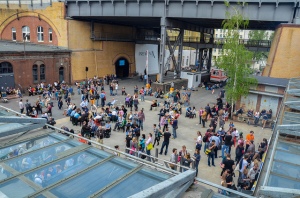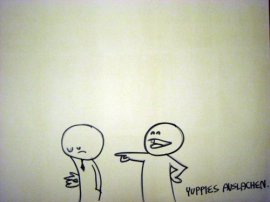Auf der Internetkonferenz Re:publica sucht die Netzgemeinde nach eine politischen Perspektive
5000 Gäste an drei Tage, knapp 200 Stunden Vorträge, Workshops und Diskussionen auf neun Bühnen sowie 116.000 Menschen, die sich die Sessions per Livestream bei Spiegel online anschauten – Das sind die beeindruckenden Zahlen der Re:publica 2013. Doch was bleibt inhaltlich vom alljährlichen Klassentreffen der Internetgemeinde in der Station Berlin? Die Antwort ist leider recht kurz: Wenig. Letztlich präsentiert ein kleiner Mann mit roter Irokesenfrisur und Schnäuzer die stärkste These: “Netzpolitik ist in zuallererst Politik!”.
Sascha Lobo, seines Zeichens Internetkenner, Power-Blogger und Spiegel-Kolumnist, hält traditionell den Abschlussvortrag des ersten Konferenztages. Mit seiner Politik-These hatte er den Geist der diesjährigen Re:publica vorweggenommen. Wesentlich politischer als in den letzten Jahren kam allein das Programm daher. Drossencom, Leistungsschutzrecht, Weiblichkeit im Internet und die Frage nach der politischen Zukunft der Netzgemeinde waren die beherrschenden Themen. Ein Zeichen dafür: Anne Wizoreck, die im vergangenen Jahr mit ihrer Feminismus-Kampagne #aufschrei auf Twitter für Furore gesorgt hatte durfte den Abschlussvortrag auf der Hauptbühne halten.
Es scheint fast so, als wollte die Veranstalter GmbH um Spreeblick-Blogger Johnny Haeusler, Creative Commons-Kopf Markus Beckedahl und Andreas Gebhard, Geschäftsführer der Open Source Marketing Agentur Newthinking nach der Flausch-Re:publica 2012 , die unter dem siegestrunkenden Eindruck des verhinderten ACTA-Gesetzes und den Erfolgen der Piratenpartei gestanden hatte, eine Aufbruchsstimmung verbreiten. So hatte auch Beckedahl in der abschließenden Pressemitteilung kämpferische Worte parat: “Setzt euch dafür ein, dass unsere Freiheit auch im Internetzeitalter erhalten bleibt. Kämpft für Grundrechte und klärt andere auf.“
Freie Internetzugänge, weniger Urheberrecht sowie barrierefreies und unabhängiges Surfen – Die politischen Standpunkt der Szene sind schon länger ausformuliert. Doch den richtigen Weg diese auch zu vermitteln hat sie bisher nicht gefunden. Schließlich lassen sich etliche gute Argumente für den Erhalt des Urheberrechts finden und auch den Ruf nach ungedrosselten Internetzugängen wird jeder Wirtschaftsweise mit Blick auf Nachfrage und Marktsituation lächelnd als Idealismus abtun. Es gilt die Frage zu beantworten, warum unsere Gesellschaft genau dieses offene Internet braucht.

Bei meist eher mittelmäßigen Vorträgen war der eigentliche Star der #rp13 der Innenhof. Foto: http://www.flickr.com/photos/ebbesand
Beantworten konnte die Frage keiner der einzelnen Speaker, zu denen neben bekannten Szene-Aktivisten wie Kathrin Passig oder Raul Krauthausen auch Daimler-Vorstandschef Dieter Zetsche und Wirtschaftsjournalist Wolf Lotter gehörten. Im Gegenteil: Es lässt sich erkennen, dass die meisten Blogger eben keine Sozial- oder Politikwissenschaftler sind. Ihren Vorträgen hing oft eine “Guck mal, das hab ich in den letzten Monaten gemacht!”-Attitüde an. Starke Thesen waren rar.
Die Antwort auf die Frage nach der gesellschaftlichen Relevanz eines freien Internets könnte stattdessen in der gewaltigen Summe der am Berliner Gleisdreieck vorgestellten Projekte versteckt sein. Denn Projekte wie das Lokalpolitiknetzwerk Offenes Köln, das Social Media-Tool Reclaim.fm und die offene Wikipedia-Datenbank Wikidata wären unvorstellbar ohne Aktivisten, die sich frei im Netz bewegen können und eine Community, die diese Projekte finanziell, ideell und intellektuell unterstützt. Ohne die demokratische Mitmach-Kultur des Internets wären viele der vorgestellten Projekte oder Aktionen nicht realisierbar gewesen, oder sie wären nicht so bekannt geworden.
Somit bleibt am Ende der #rp13, wie die Re:publica in der Szene abgekürzt wird, eine Mischung aus Ernüchterung und Vorfreude. Es stehen viele wichtige netzpolitische Fragen in den nächsten Jahren an. Vielleicht hat diese Konferenz der Netzgemeinde die Lektion mit auf den Weg gegeben, künftig politischer zu agieren, um die Ziele durchzusetzen. Eine Roadmap für den politischen Kampf hatte wieder Sascha Lobo parat: “Wir müssen uns in Zukunft, bei dem was wir machen und was wir sagen immer Fragen: Was würde Merkel überzeugen?”



 Posted by frankwombat
Posted by frankwombat 



 OK, now it is obvious.
OK, now it is obvious.  By the way. Shut down google would be a great idea in the view of the old elite. Google is doing a lot of stuff, which afford the use and distribute of free material is the internet. Google books is only one example, but a god one. In this case the court is on the side of the shared knowledge maintainer. They let google digitalise and distribute books from different authors without asking them about there personal copyrights. The american court used
By the way. Shut down google would be a great idea in the view of the old elite. Google is doing a lot of stuff, which afford the use and distribute of free material is the internet. Google books is only one example, but a god one. In this case the court is on the side of the shared knowledge maintainer. They let google digitalise and distribute books from different authors without asking them about there personal copyrights. The american court used 
